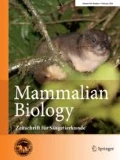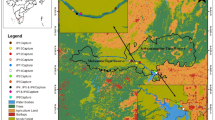Abstract
The Laotian rock rat or Kha nyou (Laonastes aenigmamus) is a small mammal species that was discovered in Central Lao People's Democratic Republic (Lao PDR) in 1996. After this discovery, the Laotian rock rat was recognized as a living fossil of the family Diatomyidae, other members of which have been extinct more than 11 million years. Previous studies have been limited to the taxonomy of the species, but information on its behavior and ecology is still lacking. Our study on home range size and movement distances of the Laotian rock rat was conducted using radio tracking in Mouang-doy village, Phou Hin Poun National Biodiversity Conservation Area, central Lao PDR. We equipped four live-trapped Laotian rock rats (3 males and 1 female) with radio collars between December 2009 and January 2011. Radio-collared animals were tracked every thirty minutes and for at least five consecutive days per month. The averaged home ranges of the Laotian rock rat in the dry season and in the wet season were 1.69 ha (SD = 0.53; n = 4) and 1.49 ha (SD = 0.46; n = 3), respectively, and were not significantly different. The home ranges of radio-collared Laotian rock rats overlapped among individuals, and overlapped area between pairs of animals ranged from 30.21 to 75.89%. The mean daily movement distances were 1602 m (SD = 150.13; n = 3 individuals) and 1578 m (SD = 52; n = 3 individuals) for the dry season and the wet season, respectively, with no statistically significant difference. This study also indicated that the Laotian rock rat is cathemeral. We would suggest additional studies to better understand the behavioral ecology of the Laotian rock rats, especially with regards to the comparison between sexes and social organization.



Similar content being viewed by others
References
Aplin KP, Brown PR, Jacob J, Krebs CJ, Singleton GR (2003) Field methods for rodent studies in Asia and the Indo-Pacific. BPA Print Group, Melbourne
Beck-King H, Helversen OV, Beck-King R (1999) Home range, population density, and food resources of Agouti paca (Rodentia: Agoutidae) in costa rica: a study using alternative methods. Biotropica 31:675–685. https://doi.org/10.1111/j.1744-7429.1999.tb00417.x
Boyle SA, Lourenço WC, Silva LR, Smith AT (2009) Home range estimates vary with sample size and methods. Folia Primatolo 80:33–42
Burt WH (1943) Territoriality and home range concepts as applied to mammals. J Mammal 24:346–352
Christman SP (1977) Plot mapping: estimating densities of breeding bird territories by combining plot mapping and transect techniques. Condor 86:237–241
Cooper LD, Randall FA (2007) Seasonal changes in home range of the giant kangaroo rat (Ripodomys ingens): a study of flexible social structure. J Mammal 88:1000–1008. https://doi.org/10.1644/06-MAMM-A-197R1.1
Dawson MD, Marivaux L, Li CK, Beard KC, Metais G (2006) Laonastes and the ‘‘Lazarus Effect’’ in recent mammals. Sci 311:1456–1458
Douangboupha B, Khamphoukeo K, Herbreteau V, Cornette R, Hugot JP, Morand S (2009) New pieces of information about the Kha-nyou, the recently discovered enigmatic rodent from the Lao PDR. J Agric For 20:48–54
Douglass RJ, William WJ, Semmens J, Matlock-Cooley SJ, Kuenzi AJ (2006) Deer mouse movement in peridomestic and sylvan settings in relation to Sin Nombre virus antibody prevalence. J Wildl Dis 42:813–818. https://doi.org/10.7589/0090-3558-42.4.813
Duckworth JW (2016) Laonastes aenigmamus. The IUCN red list of threatened species 2016:e.T136474A22199035. https://doi.org/10.2305/IUCN.UK.2016-2.RLTS.T136474A22199035.en. https://www.iucnredlist.org/species/136474/22199035
Ebensperger LA, Sobrero R, Campos V, Giannoni SM (2008) Activity, range areas, and nesting patterns in the viscacha rat Octomys mimax. J Arid Environ 72:1174–1183. https://doi.org/10.1016/j.jaridenv.2008.02.003
Eccard JA, Meyer J, Sundell J (2004) Space use, circadian activity pattern, and mating system of the nocturnal tree rat Thaillomys nigricauda. J Mammal 85:440–445. https://doi.org/10.1644/BEM-039
Flynn LF (2007) Origin and evolution of the Diatomyidae, with clues to Paleoecology from the fossil record. Bull Carnegie Mus Nat Hist 39:173–181. https://doi.org/10.2992/0145-9058(2007)39[173:OAEOTD]2.0.CO;2
Gregory T (2017) Home range estimation. In: Bezanson M, MacKinnon KC, Riley E, Campbell CJ, Nekaris KAIA, Estrada A, Di Fiore AF, Ross S, Jones-Engel LE, Thierry B, Sussman RW, Sanz C, Loudon J, Elton S, Fuentes A (eds) The international encyclopedia of primatology. Wiley, Hoboken, pp 1–4. https://doi.org/10.1002/9781119179313.wbprim0177
Harris JH, Leitner P (2004) Home range size and use of space by adult Mohave ground squirrels, Spermophilus mohavensis. J Mammal 85:517–523. https://doi.org/10.1644/1383951
Hixon M (1980) Food production and competitor density as determinants of feeding territory size. Am Nat 115:510–530
Houser AM, Somers MJ, Boast LK (2009) Home range use of free-ranging cheetah on farm and conservation land in Botswana. South Afr J Wild Res 39:11–22. https://doi.org/10.3957/056.039.0102
Huchon D, Chevret P, Jordan U, Kilpatric CW, Ranwez V, Jenkins PD, Bosius J, Schitz J (2007) Multiple molecular evidences for a living mammalian fossil. Proc Natl Acad Sci 104:7495–7499. https://doi.org/10.1073/pnas.0701289104
IUCN (2019) The IUCN red list of threatened species. Version 2019–2. https://www.iucnredlist.org
Jenkins PD, Kilpatrick CM, Robinson MF, Timmins RJ (2005) Morphological and molecular investigations of a new family, genus and species of rodent (Mammalia: Rodentia: Hystricognatha) from Lao PDR. Syst Biodivers 2:419–454. https://doi.org/10.1017/S1477200004001549
Kenward RE (2001) A manual for wildlife radio tagging. Academic Press, London
Lao National Assembly (2007) Wildlife and aquatic animal law. Lao PDR, Vientiane
Menzel JM, Ford WM, Edwards JW, Terry TM (2006) Home range and habitat use of the vulnerable virginia northern flying squirrel Glaucomys sabrinus fuscus in the central Appalachian Mountains, USA. Oryx 40:204–210. https://doi.org/10.1017/S0030605306000494
Mohr CO (1947) Table of equivalent populations of North American small mammals. Am Midl Nat 37:223–249
Moraes JEA, Chiarello AG (2005) A radio tracking study of home range and movement of the marsupial (Micoureus demerarae) (Mammalia, Didelphidae) in the Atlantic forest of south-eastern Brazil. Rev Bras Zool 22:85–91. https://doi.org/10.1590/S0101-81752005000100011
Nathan R, Getz WM, Holyoak M, Kadmon R, Revilla E, Saltz D, Smouse PE (2007) What is movement ecology? Ecol Soc Am Annu Meet Abstr. https://doi.org/10.1073/pnas.0800375105
Ofstad E, Herfindal I, Solberg EJ, Saether B (2016) Home ranges, habitat and body mass: simple correlates of home range size in ungulates. Proc R Soc B Biol Sci 283:20161234. https://doi.org/10.1098/rspb.2016.1234
Orteca JC (1990) Home-range size of adult rock squirrel (Spermophilus variegates) in southeastern Arizona. J Mammal 71:171–176. https://doi.org/10.2307/1382164
Ostfeld RS (1985) Limiting resources and territoriality in microtine rodents. Am Nat 126:1–15
Priotto BJ, Steinmann A, Polop J (2002) Factors affecting home range size and overlap in Calomys venustus (Murdae: Sigmonontinae) in Argentine agro-ecosystems. Mamm Biol 67:97–104
Priotto JW, Steinmann AR (1999) Factors affecting home range size and overlap in Akodon azarae (Muridae: Sigmodontinae) in natural pasture of Argentina. Acta Theriol 44:37–44. https://doi.org/10.4098/AT.arch.99-4
Quirici V, Castro RA, Ortiz-Tolhuysen L, Chesh AS, Burger JR, Miranda E, Cortes A, Hayes LD, Ebensperger LA (2010) Seasonal variation in the range areas of the diurnal rodent Octodon degus. J Mammal 91:458–466. https://doi.org/10.1644/08-MAMM-A-337.1
Saiful AA, Idris AH, Rashid YN, Tamuran N, Hayashi F (2001) Home range size of sympatric squirrel species inhabiting a lowland dipterocarp forest in Malaysia. Biolotopica 33:346–351. https://doi.org/10.1111/j.1744-7429.2001.tb00186.x
Sankar K, Qurenshi Q, Nigam P, Nigam P, Malik PK, Sinha PR, Mehrotra RN, Gopal R, Bhattacharjee S, Mondal K, Gupta S (2010) Monitoring of reintroduced tigers in Sariska tiger reserve, western India: preliminary findings on home range, prey selection and food habits. Trop Conserv Sci 3:301–318. https://doi.org/10.1177/194008291000300305
Schmidt NM, Berg TB, Jensen TS (2002) The influence of body mass on daily movement patterns and home ranges of the collared lemming (Dicrostonyx groenlandicus). Can J Zool 80:64–69. https://doi.org/10.1139/z01-203
Schradin C, Schmohl G, Rödel HG, Schoepf I, Treffler SM, Brenner J, Bleeker M, Schubert M, König B, Pillay N (2010) Female home range size is regulated by resource distribution and intraspecific competition: a long-term field study. Anim Behav 79:195–203. https://doi.org/10.1016/j.anbehav.2009.10.027
Sharpe D, Goldingay RL (2007) Home range of the Australian squirrel gliger, Petaurus norfolcensis (Diprotodontia). J Mammal 88:1515–1522. https://doi.org/10.1644/06-MAMM-A-404R1.1
Simcharoen S, Barlow A, Simcharoen A, Smith LD (2008) Home range and daytime habitat selection of Leopards in Huai Kha Khaeng wildlife sanctuary. Biol Conserv 141:2242–2250. https://doi.org/10.1016/j.biocon.2008.06.015
Sommer S (1996) Ecology and social structure of Hypogeomys antimena, an endemic rodent of the dry deciduous forest in western Madagascar. Biogeogr Madag 1996:295–302
Spencer W (2012) Home ranges and the value of spatial information. J Mammal 93:929–947. https://doi.org/10.1644/12-MAMM-S-061.1
Timmins RJ (1997) Note on wildlife and habitats in Khammouan limestone national biodiversity conservation area, Khammouan Province, Lao PDR from visits between 1994 and 1996. Wildlife Conservation Society. Lao PDR, Vientiane
Vongsa U (2010) Distribution, natural history and threat of Kha Nyou (Laonastes aenigmamus). M.S. Thesis, National University of Laos, Vientiane, Lao PDR
Wells K, Kalko EKV, Lakim MB, Pfeiffer M (2008) Movement and ranging patterns of a tropical rat (Leopoldamys sabanus) in logged and unlogged rain forest. J Mammal 89:712–720. https://doi.org/10.1644/07-MAMM-A-074R2.1
Wells K, Lakim MB, Pfeiffer M (2006) Nest sites of rodents and tree shrews in Borneo. Ecotropica 12:141–149
Withey JC, Bloxton TD, Marzluff JM (2001) Effects of tagging and location error in wildlife radiotelemetry studies. In: Millspuagh JJ, Marzluff JM (eds) Radio tracking and animal population. Academic Press, California, pp 43–75
Wolff JO (1985) The effects of density, food, and interspecific interference on home range size in Peromyscus leucopus and Peromyscus maniculatus. Can J Zool 63:2657–2662
Zwicker K (1989) Home range and spatial organization of the beach vole, Microtus breweri. Behav Ecol Sociobiol 25:161–170. https://doi.org/10.1007/BF00302915
Acknowledgements
We would like to express our sincere thanks to the Department of Forest Biology, Faculty of Forestry, Kasetsart, and the Faculty of Forestry Science (FFS), the National University of Laos (NUoL), for giving Mr. Thananh Khotpathoom the opportunity to study and providing some facilities on field study. Many people have assisted us during the realization of this research in the field and we sincerely express our gratitude to them all. We are especially grateful to the officials of PHP NBCA unit as they have assisted us on the difficult tasks of official document procuring. We would like to thank Dr. Greg Nagle, Dr. Martin M Balagat, and Ms. Alexa Rose for proof reading of this manuscript. We would also like to express our gratitude to two students from the FFS, NUoL, for their active roles and working with us to gather all the necessary data in the field. Finally, we wish to thank two anonymous reviewers and editors for their insightful comments and suggestions to improve the manuscript.
Author information
Authors and Affiliations
Corresponding author
Additional information
Publisher's Note
Springer Nature remains neutral with regard to jurisdictional claims in published maps and institutional affiliations.
Handling editor: Heiko G. Rödel.
Electronic supplementary material
Below is the link to the electronic supplementary material.
Rights and permissions
About this article
Cite this article
Khotpathoom, T., Vu, T.T., Bhumpakphan, N. et al. Using radiotelemetry to identify the home range and daily movement of a “living fossil”: the Laotian rock rat (Laonastes aenigmamus). Mamm Biol 100, 377–384 (2020). https://doi.org/10.1007/s42991-020-00039-5
Received:
Accepted:
Published:
Issue Date:
DOI: https://doi.org/10.1007/s42991-020-00039-5




